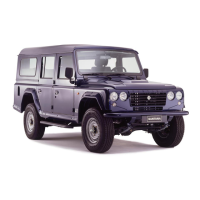3F-2 WHEELS AND TIRES
GENERAL DESCRIPTION
TIRES
Concerning tires size to be used in this vehicle, see the OWNER´S MANUAL. The tyres are of tubuless type. They are
designed to operate satisfactorily with loads up to the full rated load capacity when inflated to the recommended inflaction
pressure.
Correct tire pressures and driving habits have an important influence on tire life heavyh corniring, excessively rapid
acceleration, and unnecesary sharp braking increase tire wear.
REPLACEMENT TIRES
When replacement in encessary, the original equipment type tire should be used. Refer tothe Tire Placard. Replacement
tires should be of the same size, load range and construction as those originally on the vehicle. Use of any other size or
type tire may affect ride, handling, speedometer/odometer calibration, vehicle ground clearance and tire or snow chain
clearence to the body and chassis.
NOTE:
Do not mix different tupes of tires on the same vehicle such as radial, bras-belted tires except in emergencies,
because vehicle handling may be sectously affected and may result in loss of control.
It is recommended that new tires be installed in pairs on the same axle. If necessary to replace only one tire, it should be
paired with the tire having the must tread, to equalize braking traction.
WHEELS REPLACEMENT
Wheels must be replaced if they are bent, dented, have excessive lateral or radial renout, leak air through welds, have
alongated bolt holes, if lug nuts won´t stay tight, or if they are heavily rusted.
Wheels for replacement must be equivalent to the originally equipped wheels in load capacity, diameter, rim width, off-set
and mounting configuration. A wheel of improper size or type may affect wheel and bearing life, breaking cooling,
speedometer/odometer, calibration, ground clearence to the body and chassis.

